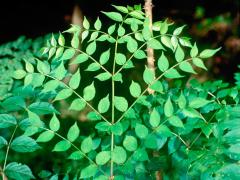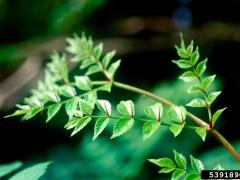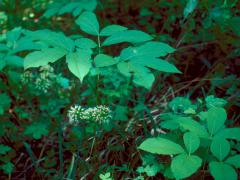Invasive Species: Aralia elata, Japanese Angelica Tree
This invasive plant is an upright deciduous shrub or tree in the Araliaceae family that reaches a height of 20 to 40 feet and a width of 15 to 30 feet, with an irregular, spreading, multi-stemmed form. Coarse, thick stems have sharp prickles and prominent large leaf scars. The stems are covered in spines. Large, dark green, alternate leaves (2 to 4 feet long) are bi- or tri-pinnately compound. Leaves are pubescent beneath, with veins running to the ends of the serrations. In fall, leaves turn yellow to reddish purple and may drop early in season. The cream white flowers grow in large panicles and bloom in late summer (July through August). Inflorescence branches from the base. Small purple to black berries are eaten and distributed by wildlife. This invasive plant also suckers from its base and spreads. Its large seed production and rapid growth allow this tree to invade new areas quickly. This plant prefers sun to partial shade, meaning that it can invade open areas and forest edges. It can grow in a range of soil types but prefers moist, well-drained soil. Luxuriant foliage casts dense shade, which can shade out the native understory plants.
What are invasive species, and why should we be concerned about them?
Taxonomy: Scientific and Common Names for This Species
Magnoliopsida > Apiales > Araliaceae (Miq.) Seem
Synonym(s):Japanese angelica tree, Hercules-club
Aralia elata – USDA PLANTS Profile
Distribution Maps
Japanese angelica tree – The reported distribution of this invasive species across the United States (Source: Invasive Plant Atlas of the United States)
Up-to-the-minute distribution maps and why they are important
Reporting This Invasive Species
What is the best way to report the occurrence of an invasive species?
How to report an invasive species sighting to EDDMapS – Early Detection & Distribution Mapping System
EDDMapS – Report an invasive species to EDDMapS.
County Extension Offices – Find your county Extension office on this map provided by USDA.
How to Identify
This invasive species can be identified by looking for the characteristics described in the paragraphs that follow.
Tree
Japanese angelica tree is an upright deciduous shrub or tree in the Araliaceae family that reaches a height of 20 to 40 feet and a width of 15 to 30 feet, with an irregular, spreading, multi-stemmed form. Coarse, thick stems have sharp prickles and prominent large leaf scars. The stems are covered in spines.
 |
|
| John M. Randall, The Nature Conservancy, bugwood.org | bugwood.org |
Foliage
Large, dark green, alternate leaves (2 to 4 feet long) are bi- or tri-pinnately compound. Leaves are pubescent beneath, with veins running to the ends of the serrations. In fall, leaves turn yellow to reddish purple and may drop early in season.
 |
 |
| John M. Randall, bugwood.org | John M. Randall, bugwood.org |
Flower
The cream white flowers grow in large panicles and bloom in late summer (July through August). Inflorescence branches from the base.
 |
 |
| John M. Randall, bugwood.org | John M. Randall, bugwood.org |
Fruit
Small purple to black berries are eaten and distributed by wildlife. This invasive plant also suckers from its base and spreads.
| bugwood.org | bugwood.org |
Native Aralia Species Can Resemble Japanese Angelica Tree
Aralia spinosa, devil’s walkingstick – Images at Invasive.org
 |
 |
| John D. Byrd, Mississippi State University, bugwood.org | James H. Miller & Ted Bodner, Southern Weed Science Society, bugwood.org |
Aralia nudicaulis, wild sarsaparilla – Images at Invasive.org
 |
 |
| Dave Powell, USDA Forest Service, bugwood.org | Dave Powell, USDA Forest Service, bugwood.org |
Additional Images for Japanese Angelica Tree
Japanese angelica tree – Images at Invasive.org
Learning Resources for Japanese Angelica Tree
Aralia elata Identification Card – U.S. Fish & Wildlife Service
Aralia elata Fact Sheet – U.S. Fish & Wildlife Service
Additional Information, Biology, Control and Management Resources
Control and management recommendations vary according to individual circumstances. Location, habitat, weather, and a variety of other conditions are factors that help determine the best treatment choice. To find the safest and most effective treatment for your situation, consult your state’s land-grant institution. If you will use chemicals as part of the control process, always refer to the product label.
United States Land-Grant University System – Find your Land-Grant University’s College of Agriculture, University Cooperative Extension Service, or other related partner on this map provided by USDA.
Non-native Plant Invasiveness Ranking Form – New York
Invasive Plant Fact Sheet – Central Jersey Invasive Species Strike Team
Invasive Plants and Their Native Look-alikes – An Identification Guide for the Mid-Atlantic
Weed of the Week – USDA Forest Service
